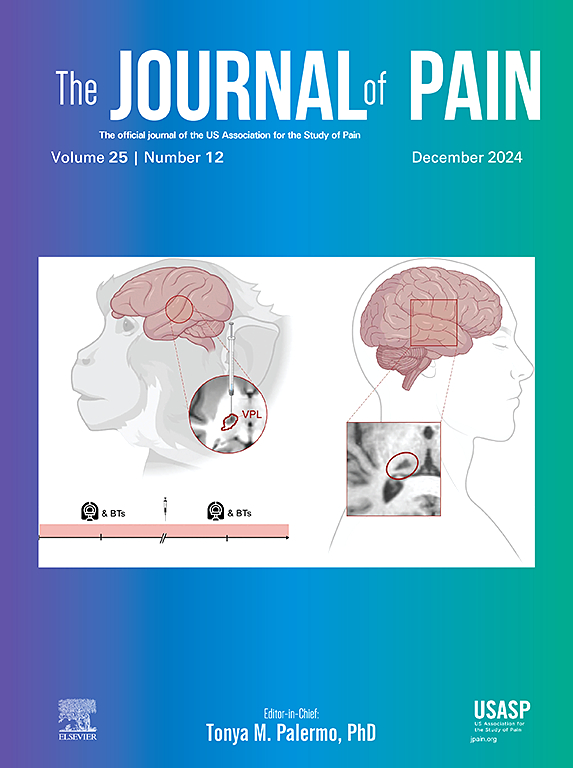哪些慢性严重背痛患者没有接受疼痛治疗?
IF 4
2区 医学
Q1 CLINICAL NEUROLOGY
引用次数: 0
摘要
慢性疼痛患者在获得治疗方面存在很大障碍。由于大多数研究依赖于临床样本,因此人们对未接受治疗的慢性严重背痛患者知之甚少。我们试图探究在过去 3 个月中未接受疼痛治疗的美国成年慢性严重背痛患者的人口、社会经济和临床特征。在这项横断面研究中,我们使用了 2019 年全国健康访谈调查的数据,并确定了在过去 3 个月中接受/未接受慢性严重背痛治疗(包括自我管理策略)的人群。我们使用双变量和多变量分析来探讨与未接受疼痛治疗相关的因素。近 21% 的慢性严重背痛患者在过去三个月中没有接受过治疗。77)、高中以下学历(OR,2.37;95% CI 1.52-3.68)、无保险(OR 1.77;95% CI 1.21-2.59)、居住在南方(OR 2.05;95% CI 1.40-3.00)、患有心脏病(OR 1.47;95% CI 1.11-1.93)。单亲家庭、抑郁症和多种并发症与接受治疗有关。我们的结论是,五分之一的慢性严重背痛患者至少在三个月内未接受治疗,而社会经济因素与未接受治疗密切相关。观点:在具有全国代表性的慢性严重背痛患者样本中,有五分之一的患者至少在三个月内没有接受治疗。社会经济因素与未接受治疗密切相关。有必要实施一些解决方案来减少治疗障碍。本文章由计算机程序翻译,如有差异,请以英文原文为准。
Who Are the People With Chronic Severe Back Pain Not Receiving Pain Treatment?
There is substantial access to care barriers for persons with chronic pain. Little is known about persons who do not receive treatment for chronic severe back pain as most studies rely on clinical samples. We sought to explore demographic, socioeconomic, and clinical characteristics of U.S. adults with chronic severe back pain who had not received pain care in the preceding 3 months. In this cross-sectional study, we used data from the 2019 National Health Interview Survey and identified persons who did/did not receive treatment (including self-management strategies) in the last 3 months for their chronic severe back pain. We used bivariate and multivariable analyses to explore factors associated with not receiving pain treatment. Almost 21% of persons with chronic severe back pain did not receive treatment in the past 3 months. The following were independently associated with not having treatment in the preceding 3 months: male sex (OR: 1.40, 95% CI: 1.11–1.76), living near or below the poverty level (OR: 1.92, 95% CI: 1.33–2.77), having less than a high school education (OR: 2.37, 95% CI: 1.52–3.68), not having insurance coverage (OR: 1.77, 95% CI: 1.21–2.59), living in the South (OR: 2.05, 95% CI: 1.40–3.00), and having heart disease (OR: 1.47, 95% CI: 1.11–1.93). Being a single parent, having depression, and multiple comorbid painful health conditions were associated with having treatment. Our conclusions are that one-fifth of persons with chronic severe back pain did not receive treatment for at least 3 months and socioeconomic factors were highly associated with not receiving treatment.
Perspective
In a nationally representative sample of persons with chronic severe back pain, one-fifth did not receive treatment for at least 3 months. Socioeconomic factors were highly associated with not receiving treatment. There is a need to implement solutions to reduce barriers to care.
求助全文
通过发布文献求助,成功后即可免费获取论文全文。
去求助
来源期刊

Journal of Pain
医学-临床神经学
CiteScore
6.30
自引率
7.50%
发文量
441
审稿时长
42 days
期刊介绍:
The Journal of Pain publishes original articles related to all aspects of pain, including clinical and basic research, patient care, education, and health policy. Articles selected for publication in the Journal are most commonly reports of original clinical research or reports of original basic research. In addition, invited critical reviews, including meta analyses of drugs for pain management, invited commentaries on reviews, and exceptional case studies are published in the Journal. The mission of the Journal is to improve the care of patients in pain by providing a forum for clinical researchers, basic scientists, clinicians, and other health professionals to publish original research.
 求助内容:
求助内容: 应助结果提醒方式:
应助结果提醒方式:


